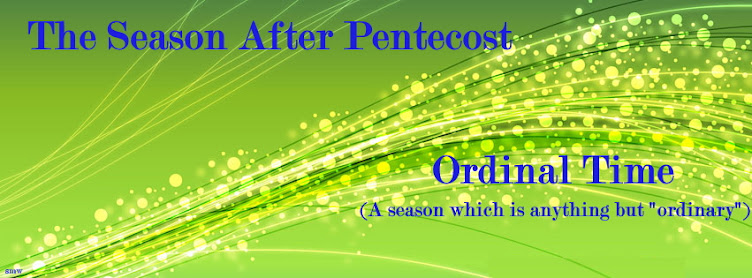The Great O Antiphons
The history of the Great O Antiphons dates back to as early as the third century (1) as an ancient part of our liturgy. Boethius, who was around in the late 5th to early 6th century, makes reference to them (2). The actual existence of the O Antiphons may go back to the earliest days of the Church. They are part of the Vespers Liturgy of Hours during the octave before the Christ Mass (Christmas) which begins on December 17 and goes through the 23rd. One December 24th the vespers are for Christmas Eve.December 17 - O Wisdom
December 18 - O Adonai
December 19 - O Root of Jesse
December 20 - O Key of David
December 21 - O Dawn
December 22 - O King of Gentiles
December 23 - O Emmanuel
From Fr. Zuhlsdorf's ("Fr. Z") page on the subject:
Here are two more interesting notes about these O Antiphons.Perhaps the "backwards" acrostic can be related to the earlier language of Hebrew, as it is read from right to left?
The first is not apparent in English, but it can be seen clearly in the official language of the Roman Catholic Church: Latin. The Latin versions of each of the titles of the Messiah are: Sapientia (Wisdom), Adonai (Lord), Radix (Root), Clavis (Key), Oriens (Dawn), Rex (King), and Emmanuel (Emmanuel). Take the first letters of each of the titles, starting with the last and working back to the first. You spell: EROCRAS or "ero cras... I will be (there) tomorrow".
The song "O Come, O Come, Emmanuel" is simply a reworking of the seven O Antiphons. When you sing it, you are joining yourself to a vast throng of Christians stretching back across centuries and spanning the whole of the earth who prayed as all Christians do, "Come, Lord Jesus!" (Rev 22:20) (3)
According to hymology, the English form of the hymn, which most of us know and sing during Advent, comes to us from an Anglican priest who discovered the medieval antiphons, which were chanted in Latin, and he translated them into English in the mid 19th century. The melody is actually taken from a funeral rite and the words "Bone iesu, dulcis cunctis" were used. That funeral rite dates back to the 15th century. It is also possible that the funeral rite borrowed from the Advent rite which had not been recorded/written or perhaps just not discovered yet - which is quite possible since some of what we know of this hymn has come to light as recent as the 1960's. (4) and (5).
Practices / Traditions
1) The Jesse TreeA special tree, for Advent, many start with December 1 and have 24-25 ornaments for this tree. Each ornament speaks of the history of Jesus' roots - in the line of Jesse (the father of King David). December 17-23 you use ornaments specific to the O Antiphons. (6) This is nice, but the O Antiphons may get "lost" in the shuffle of all the other ornaments and not have as significant impact. There's still the tradition of the Advent Calendar too, typically it has a "window" you open for each day of Advent with a special picture and/or Bible verse for the day. Some use a shadow box and place a special ornament in each opening for each day of Advent (see examples below).
Personally, I would prefer a tree specific to the O Antiphons...
It's simple, but direct and as we pray and sing as a family the antiphons from O Come, O Come Emmanuel each day - the song and the season has deeper meaning.
2) The O Antiphon House
There are several variations of this one. One of my favorites is a shadow box frame in the shape of a house with the seven openings, each to contain an ornament or a block with the antiphon of the day on it.
3) Be Creative!
Perhaps you have an idea of your own or a tradition celebrated in your family. If so, please feel free to share it here! Here's another idea, using candles: (7)
Sources:
(1) https://www.catholicculture.org/culture/liturgicalyear/activities/view.cfm?id=958
(2) http://www.catholiceducation.org/en/culture/catholic-contributions/what-are-the.html
(3) http://www.wdtprs.com/JTZ/o_antiphons/
(4) http://www.newliturgicalmovement.org/2008/12/truth-about-veni-veni-emmanuel.html#.Vn7aJVngRx8
(5) https://www.ccwatershed.org/blog/2015/dec/16/veni-veni-emmanuel-original-setting-two-voices/
(6) https://www.catholicculture.org/culture/liturgicalyear/activities/view.cfm?id=545
(7) http://familyatthefootofthecross.blogspot.com/2011/12/oantiphon-candles.html








No comments:
Post a Comment
Keep in mind while posting:
1) Please respond ON TOPIC to the article at hand.
2) Posts more than 4 weeks old are set to automatically save new comments for moderation - so your comment may not show up immediately if you're responding to an older post.
3) The "Spam Filter" is on - and randomly messages get caught in that filter. I have no control over which messages get caught in the spam filter and those that do must wait for me to mark them as "not spam." A message caught by the spam filter may show up for a moment, making you think it posted, and then disappear. Do not assume I have deleted your comment, it's probably just the spam filter and it will show up.